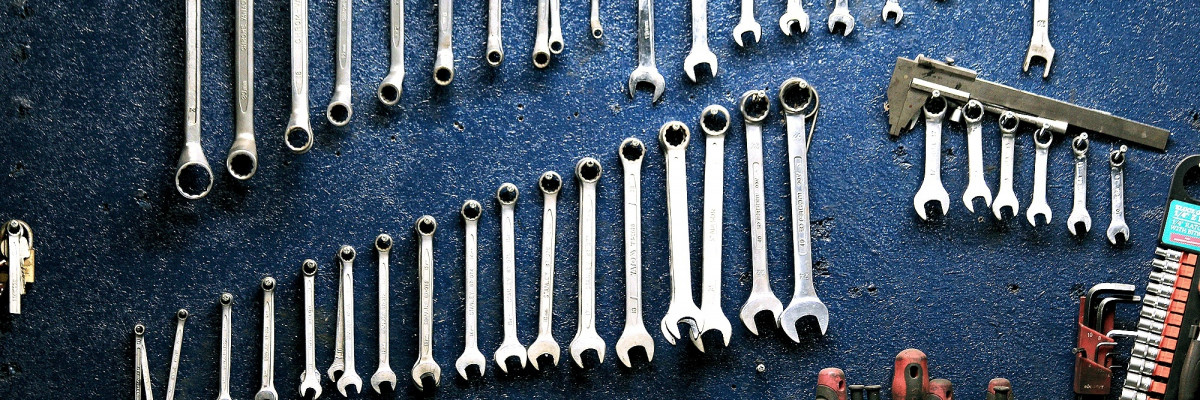Bikes are just like any other machine - the better you care for it the better it will perform. Luckily, learning to look after your bike is simple and great for peace of mind.
If you're looking for a bit more help check out Bikespace.
The 'M check' is a quick and simple check that's easy to perform regularly. You'll need your pump, chain grease and a set of allen keys.

1. Wheels
Should be tightly fitted. The nuts or quick-release lever on either side of the middle of the wheel should be tight.
Run your fingers over the spokes - there should be no loose spokes.
Check there is enough air in the tyres. The recommended tyre pressure will be written somewhere on the tyre. A firm orange is pretty good guide if you don't have a gauge.
Tyre pressure
Pumping up your tyres to the correct pressure will make sure you maintain grip and don’t exert any unnecessary effort. If you have a pressure gauge on your pump, the recommended pressure will be printed on the wall of the tyre. If you can’t find it, here’s a guide:
Road bike tyres (slick and narrow)
- 90 PSI for a 70kg rider. Add/subtract 2 PSI for every 5kg over/under 70kg
- Should be very firm to touch and almost impossible to make an indent with your thumb
Hybrid/city bike tyres (wider with tread)
- 50 PSI for the front wheel and 55 PSI for the rear wheel
- Should feel like squeezing an orange
Mountain bike tyres (wider with very thick tread)
- 36 PSI for a 70kg rider. Add 1 PSI for every 5kg over 70kg
- Due to the large volume of mountain bike tyres they don't need as much inflation
2. Saddle/seat
Ensure your saddle is firmly in place by trying to shift it from side to side and up and down. If the seat moves, use your allen keys or the quick release to tighten the frame around the seat post.
3. Chain
Make sure the chain is clean and lubricated. You only need to add a little oil – too much will pick up more dirt, making it harder to clean the chain.
4. Pedals
Your pedals should turn over smoothly and not have any sideways movement.
5. Handlebars
Your handlebars and front wheel shouldn't move independently. If the handlebars are loose and you aren't sure which screw tightens them it's best to see your local bike shop - they'll tighten them up for you on the spot.
6. Brakes
Your brakes should be responsive without rubbing on the wheel. Slowly wheel the bike alongside you and apply one brake at a time. When you squeeze your left (rear) brake lever the back wheel should lock up. When you squeeze your right (front) brake the bike should stop. If the brake lever pulls all the way to the grip you'll need to get some maintenance done.
Handy tools
Allen keys
Allen key sets are essential for any bike owner– most screws on a bike have hexagonal heads. A set has a range of different sizes, to fit the range of screw sizes on a bike. You can use them to tighten your handlebars, adjust your seat height, attach a drink bottle holder and more.
Tyre levers
Tyre levers are your best friend when you get a flat tyre. The lever end (flat end) is to slip between the wheel rim and the bead/edge of your flat tyre. The other end is to hook onto your spoke, which holds the tyre away from the rim. They are about the size of a teaspoon, you’ll need two or three to get your tyre off.
Crescent wrench
A small crescent wrench is really handy, especially if you have a slightly older bike. This adjustable spanner can be used to do up and undo bolt nuts. On some bikes, you’ll need to undo nuts to remove your wheels if you want fit your bike in the car or change a flat tyre.
Pump
There are lots of pumps out there, but they all do the same job – keeping your tyres inflated. There are two types of pump valve, Schrader or Presta. You’ll have to check that your pump works for your tyre valve, though some pumps work for both. If you’re not sure, just pop into your local bike shop, they’ll help you out.
Chain oil or lubricant
Chain oil takes the squeak out of any ride and will help your gears to shift smoothly. You don’t need to put much on your chain: a little goes a long way. As a guide, one small drop of oil per chain link is enough, or until your chain is nice and quiet. Add oil to your chain if you’ve been riding in the wet, after every 10-15 rides, or whenever your chain starts making a noise.
Don’t have the tools? Go to a Fix it stand




